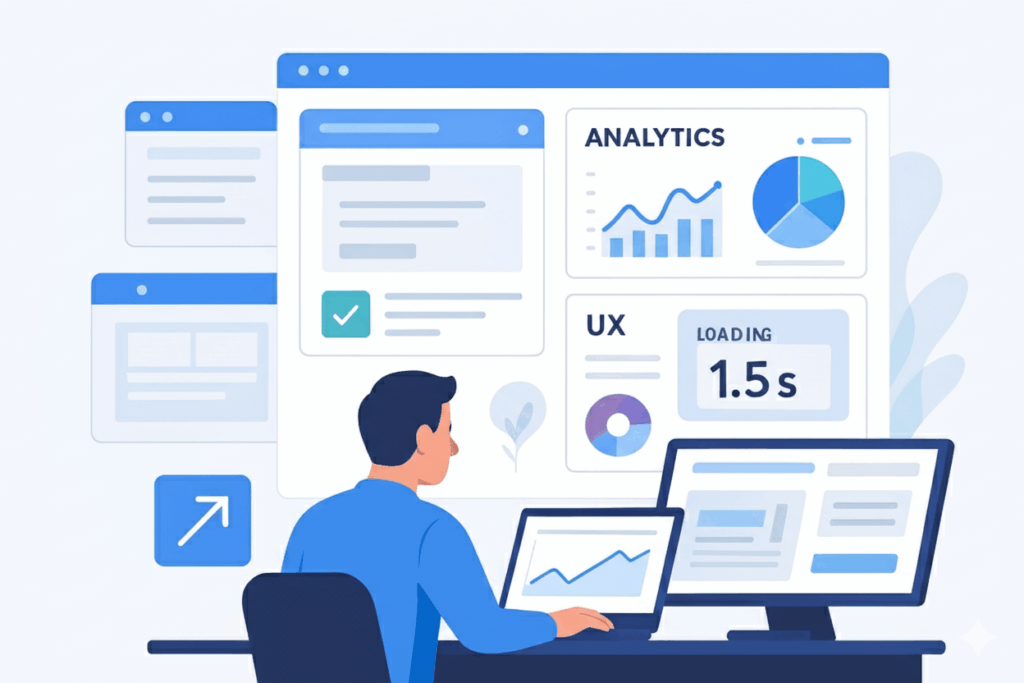Your website is often the first point of contact between your startup and potential customers. But here’s the question: is your website a powerful growth tool, or is it just a visually appealing placeholder?
Many startup founders focus on aesthetics, believing that a beautiful website alone will attract and retain visitors. While visual appeal is important, it is only one part of a successful online presence. A website must do more than look good—it must engage, inform, and convert visitors into customers.
Why Website Performance Matters
Did you know that 38% of users stop engaging with a website if the content or layout is unattractive? This statistic highlights a critical reality: even if your website looks polished, a poor user experience can drive away nearly half of your potential audience.
Common issues that undermine a website’s effectiveness include:
- Slow loading times: Every second counts. Visitors expect pages to load quickly, and delays can result in lost leads and reduced engagement.
- Unclear navigation: If users cannot easily find what they’re looking for, they leave. Intuitive menus, search functionality, and logical page hierarchy are essential.
- Outdated content: Irrelevant or incorrect information damages credibility and lowers search engine rankings.
Insights from WEAMSE Website Audits
At WEAMSE, we’ve conducted audits for over 200 websites across various industries, from tech startups to healthcare and e-commerce platforms. Through these audits, we consistently observe that small, strategic improvements can yield up to 50% higher user engagement.
Some of the key insights we’ve gathered include:
- Optimizing website speed can drastically reduce bounce rates.
- Streamlining navigation and layout ensures visitors stay longer and explore more pages.
- Refreshing content keeps your website relevant, improves SEO rankings, and builds trust with visitors.
Self-Audit Checklist for Your Website
You don’t always need an expert to spot issues. Here’s a simple self-audit checklist to evaluate your website:
- Test your website speed
Use tools like Google PageSpeed Insights or GTmetrix to analyze your loading times. Focus on optimizing images, leveraging browser caching, and minimizing code to improve performance. - Review your navigation structure
Ask yourself: is your navigation intuitive? Can users find important pages without confusion? Make sure menus are clear, categories are logical, and links are working correctly. - Check your content for relevance and accuracy
Review all pages, blog posts, and landing content. Ensure your messaging aligns with your target audience’s needs, your product/service descriptions are accurate, and any outdated information is updated. - Test responsiveness
With more than half of web traffic coming from mobile devices, your site must perform well across smartphones, tablets, and desktops. - Assess visual appeal and UX
Good design is more than aesthetics. Consider microinteractions, readable typography, consistent color schemes, and well-placed calls-to-action that guide the user journey.
The Benefits of a Well-Optimized Website
A strong website doesn’t just attract visitors; it converts them into customers. By focusing on speed, navigation, content, and UX, you can:
- Reduce bounce rates
- Increase average session duration
- Improve search engine rankings
- Enhance credibility and trust
- Boost conversions and revenue
Even incremental improvements can produce significant results. For example, simply enhancing load times and simplifying navigation can lead to a noticeable increase in leads and sales.
Common Mistakes Startups Make
Despite knowing the importance of a website, many startups fall into the following traps:
- Neglecting mobile optimization: A site that works on desktop but fails on mobile loses a huge audience.
- Ignoring analytics: Without monitoring tools like Google Analytics, you won’t know which pages perform well or where users drop off.
- Overcomplicating design: Too many elements, animations, or pop-ups can distract users from your core message.
- Skipping regular updates: Websites must evolve with your business. Stale content signals inactivity and reduces engagement.
How WEAMSE Can Help
At WEAMSE, we specialize in transforming websites into high-performing digital assets. Our audits identify bottlenecks, highlight opportunities for improvement, and provide actionable strategies tailored to your startup’s goals.
Whether you’re a founder looking to boost lead generation or a business aiming to enhance user experience, a professional website audit is your first step toward digital growth.
Frequently Asked Questions (FAQ)
Q1: How often should I audit my website?
A: Ideally, conduct a comprehensive website audit at least twice a year. Regular audits help identify performance issues, update content, and improve SEO effectiveness.
Q2: Can I improve my website speed without technical expertise?
A: Yes! Start by optimizing images, reducing large files, and using website builders with built-in speed optimization. For advanced improvements, consulting a web professional is recommended.
Q3: What is the most common website mistake by startups?
A: The most common mistake is prioritizing aesthetics over functionality. A visually appealing site that’s slow, confusing, or outdated won’t convert visitors effectively.
Q4: How does website UX affect conversions?
A: User experience directly impacts engagement. Clear navigation, quick load times, and intuitive design reduce frustration and guide visitors toward taking desired actions.
Q5: Will updating my website content improve SEO?
A: Absolutely. Fresh, relevant, and keyword-optimized content signals search engines that your website is active and authoritative, improving your rankings.

